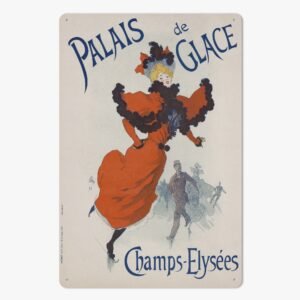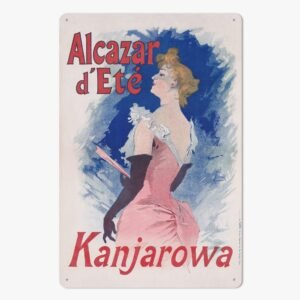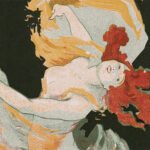Early Life and Origins
Jules Chéret was born on May 31, 1836, in Paris, France, into a modest but creative family of artisans. Though his formal education was limited, Chéret displayed remarkable artistic talent from an early age. At just 13, he began an apprenticeship with a lithographer, where he learned the foundations of printmaking — a skill that would later revolutionize the advertising world.
Chéret continued his artistic development by attending the École Nationale de Dessin, but he was largely self-taught and shaped more by practice than theory. His early career also took him to London, where he worked for several English printers. There, he was exposed to bold typographic and poster design, which greatly influenced his later work.
Mastering Lithography and Reinventing the Poster
Returning to France in the 1860s, Chéret began producing posters that fused fine art with commercial printing. At a time when advertising was primarily text-based and dull, Chéret’s vibrant, colorful lithographs were a revelation. His mastery of color lithography allowed for affordable yet richly illustrated prints, which soon adorned walls, kiosks, and boulevards across Paris.
He was among the first to elevate posters to a legitimate art form, breaking away from the rigid conventions of traditional art and advertising. His posters weren’t just commercial—they were joyous, imaginative, and beautifully composed. His unique approach earned him the title of “The Father of the Modern Poster.”
The Chérettes and His Signature Style
A defining feature of Chéret’s work was his portrayal of lively, confident, and flirtatious women—later nicknamed the “Chérettes.” These figures embodied the Belle Époque spirit: fashionable, spirited, and full of life. Unlike previous depictions of women in art as either demure or overtly seductive, Chéret’s figures were liberated, dynamic, and refreshingly human.
Chéret combined elegant linework with vibrant swirls of color, influenced both by Rococo painting and modern Parisian energy. His style bridged academic and commercial art and paved the way for other greats like Henri de Toulouse-Lautrec and Alphonse Mucha.
Collaborations and Later Career
Throughout his prolific career, Chéret designed thousands of posters, especially for cabarets, theaters, circuses, and perfume brands. He worked with famous venues like the Folies Bergère, Moulin Rouge, Palais de Glace and Théâtre de l’Opéra, and created advertisements for products like Pippermint, Pastilles Géraudel and Job cigarette papers.
In addition to his commercial work, he also produced his own albums of decorative lithographs and contributed illustrations to books. In 1890, the French government recognized his artistic contributions by awarding him the Légion d’honneur.
Legacy and Influence
Jules Chéret passed away in 1932, but his impact on visual culture is still felt today. He transformed street advertising into a joyful celebration of color and movement and laid the groundwork for both Art Nouveau and modern graphic design.
His work continues to be admired by collectors, art lovers, and historians alike. His influence can be seen in poster design, typography, and advertising aesthetics even over a century later.
Discover the timeless charm of Jules Chéret’s work. Below, explore a curated selection of his Belle Époque prints — perfect to add a touch of vintage Parisian elegance to your home.










